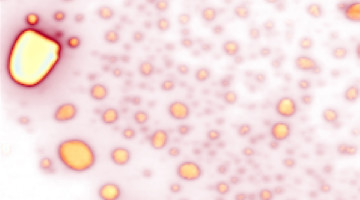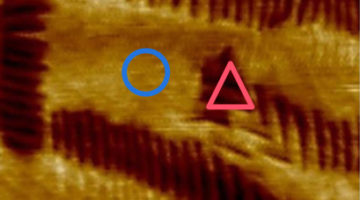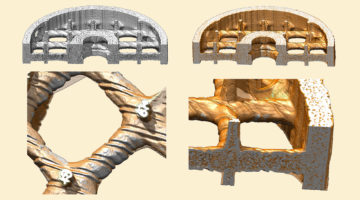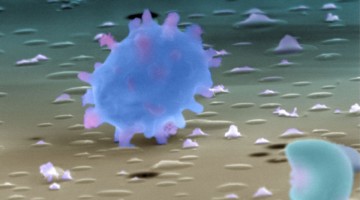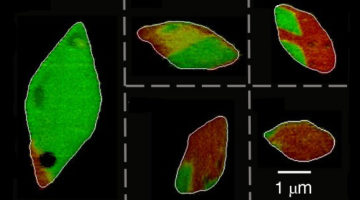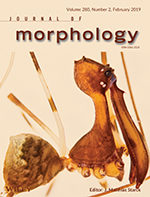Contrary to previous reports, it’s possible to create a rechargeable battery using magnesium ions if the electrode material is first conditioned at high temperature. With twice the charge of lithium ions, magnesium ions hold great promise as the basis for high-energy-density batteries suitable for use in electric vehicles. Read more »![]()
![]()
ALS Work Using Microscopy/Imaging
These techniques use the light-source beam to obtain pictures with fine spatial resolution of the samples under study and are used in diverse research areas such as cell biology, lithography, infrared microscopy, radiology, and x-ray tomography.
Tuning Material Properties with Laser Light
Researchers demonstrated that coupled electronic and magnetic properties in a material can be repeatably tuned using laser light. The results suggest the possibility of creating microelectronic devices that use a laser beam to erase and rewrite bits of information in materials engineered for random-access memory and data storage. Read more »![]()
![]()
Shape transformation and self-alignment of Fe-based nanoparticles
Magnetic nanoparticles (MNPs) have widespread applications in biotechnology, materials science, engineering, and environmental studies. Thus, much attention has been paid to their controllable synthesis. Three new functions of iron-based nanoparticles are reported: shape transformation, oxidation prevention, and self-alignment. Read more »
The Stomatopod Telson: Convergent Evolution in the Development of a Biological Shield
In this article, researchers identify multiscale structure‐mechanical property relationships within the shield-like exoskeletal telson structure of the mantis shrimp, used for defense and protection. Comparison of telsons from two evolutionarily divergent species reveal differences in macromorphology, cuticle thickness, and mineralization, imparting compressive stiffness as well as compliance for energy absorption. Read more »
Clues to the Early Solar System Preserved in a Meteorite
Scientists analyzing a tiny carbon-rich pocket inside a meteorite found unexpected chemical signatures. Their findings are the first direct evidence that material from the outer solar system may have traveled inward long before planets formed, providing insight into the early solar system. Read more »
Absorber Captures Excess Chemotherapy Drugs
Researchers have designed a biomedical device for absorbing excess chemotherapy drugs during cancer treatment, characterizing the active surface layer using x-ray microtomography. The work opens up a new route to fighting cancer that minimizes drug toxicity and enables personalized, targeted, high-dose chemotherapy. Read more »![]()
![]()
How to Catch a Magnetic Monopole in the Act
A research team has created a nanoscale “playground” on a chip that simulates the formation of exotic magnetic particles called “monopoles.” The study could unlock the secrets to ever-smaller, more powerful memory devices, microelectronics, and next-generation hard drives that employ the power of magnetic spin to store data. Read more »
Salt in the Amazon Air Comes from Local Fungi
The abundant salt in the atmosphere above the Amazon basin has long been attributed to the Atlantic Ocean. But now, using the Advanced Light Source, scientists have found that much of it originates much more locally: fungal spores in the rainforest. Pinpointing the origin will improve climate models and understanding of rainforest ecosystems. Read more »
Hidden Flow of Lithium Ions Points Way to Better Batteries
Experiments revealed that lithium ions unexpectedly flow along the surfaces of electrode particles, boosting the growth of lithium “hot spots” that shorten battery life. The results correct decades’ worth of assumptions and will help improve battery design, potentially leading to a new generation of lithium-ion batteries. Read more »![]()
Comparative morphology of cheliceral muscles using high‐resolution X‐ray microcomputed‐tomography in palpimanoid spiders
Spiders are important predators in terrestrial ecosystems, yet we know very little about their principal feeding structures—the chelicerae—an extremely important aspect of spider biology. Here, using micro‐Computed‐Tomography scanning techniques, researchers perform a comparative study to examine cheliceral muscle morphology in six different spider specimens. Read more »
- « Previous Page
- 1
- …
- 10
- 11
- 12
- 13
- 14
- …
- 19
- Next Page »
